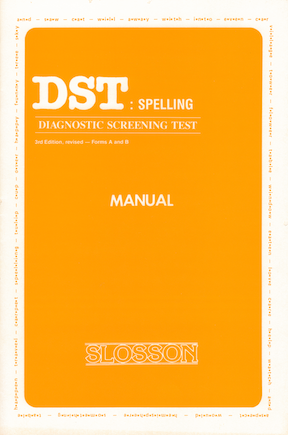Order the Entire DST Battery and Save!
Diagnostic Screening Test: Spelling
Interpretation of Data:
Several levels of data interpretation are possible from the results of the DSTS. The first level is to merely state the Grade Equivalent level achieved and suggest that spelling instruction begin there. This kind of interpretation is enhanced by utilizing the CI to determine whether beginning remedial instruction at an earlier level might be helpful and just how rapidly the student can be expected to progress.
A second level would include a comparison of spelling mastery of strict Phonics-proper words with Sight (phonics-less proper) words. This will indicate types of words needing the most drill but needs further amplification if to be really useful in the classroom.
Then, the student’s performance can be compared when he/she is required to write the words opposed to spelling them aloud. Here clues to open and less open expressive channels can be found and these strengths and weaknesses can be planned for in the child’s classroom program.
Quantity Instructor Discount Available for the DSTS.....Refer to Promos Page
1. Sight or Phonics Orientation for Spelling Instruction
2. Relative Efficiency of Verbal and Written Testing
Procedures
Two equivalent forms, designated A & B were developed and separately normed. The following correlations were obtained: Form A with Form B = .99; Form A with Form A + Form B (total) = .99; Form B with Form A + Form B (total) = .99. Percentile ranks, T-scores and Grade Equivalent scores are available for each form separately and for the two forms combined (A + B).
3. Analysis of Sequential and Gross Visual Memory
4. Analysis of Sequential and Gross Auditory Memory
Five Diagnostic Problem Areas Explored:
Third Edition (DSTS)
Grades: 1 through 12
Administration: Individual or Group Settings
The DSTS is designed in a flexible, easy to administer and score format, versatile enough to meet the individual needs and preferences of most examiners. It can be administered as a group test yielding a grade equivalent score, or can be administered in a number of useful diagnostic ways as an individual examination. The 78 test words are arranged in developmental sequence, thereby cutting administration time to between five and ten minutes. Two versions, Test Form A and Test Form B, are available and may be considered equivalent for test-retest comparisons.
5. Generally Good or Poor Potential as a Speller
Consolidation Index (CI) Computation:
The Consolidation Index (CI) reflects how solid or spotty a student’s knowledge or skill is. For example, the CI could help distinguish in a useful way between appropriate spelling programs for two students who have identical Grade Equivalent (GE) scores. If the first student got all the items correct up to the 3.6 GE level and missed all the remaining words showing good solid knowledge up to the 3.6 but virtually no knowledge beyond that point. The second student on the other hand, who also obtained a 3.6 GE but missed five items prior to the 3.6 level and passed items at the 3.8, 4.1, 4.6, 4.9 and 5.3 levels. This would indicate a spotty mastery pattern in need of review well below the 3.6 GE level, but will probably need less intensive instruction-to-mastery above that level, compared to the first student.
Test Construction:
An initial pool of spelling words was obtained by having 71 teachers, grades one through twelve submit lists of 100 words typically “taught” and mastered by average students in that teacher’s classroom. Ten phonics and ten sight words appearing on the majority of each set of these grade level word lists were selected. These were then administered to five different classes in five different schools at each grade level 1-12. Within each grade level, words were arranged in order from those spelled correctly by the largest percent of students to those by the smallest percent.
Thomas D. Gnagey
Norming and Scoring:
134.50
41.25
41.25
60.00



















